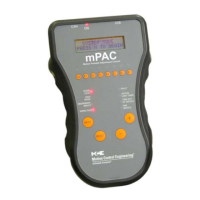User Interface
4-38 Manual # 42-02-2P24
DEIS
Door Enable Inspection Stop Switch - Activated when front door operation is allowed.
Deactivated if the elevator is on inspection or Test mode or if the door stop input has been
activated. See Spare Input, DSTI.
DEISR Door Enable Inspection Stop Switch Rear - Activated when rear door operation is allowed.
Deactivated if the elevator is on inspection or Test mode or if the door stop input has been
activated. See Spare Input, DSTI.
DOORENAB Door Enable Output. Activated when door operation is permitted. For example, if the car is
not on Inspection and not on Test mode.
DSH Door Time Shortening Output (intermediate) - Generated when a destination car call but-
ton is pressed. (Causes door dwell time to shorten if the doors are fully open).
DSHT Door Time Shortening Front Output (final) - Reflects the status of the DSHT flag. Gener-
ated if a destination car call button or the front door close button is pressed.
DSHTR Door Time Shortening Rear Output (final) - Reflects the status of the DSHTR flag. Gener-
ated if a destination car call button or the rear door close button is pressed.
ECRN Emergency Power Car Run Output - Reflects status of the emergency car run flag associ-
ated with emergency power logic. When activated, indicates the car is being prevented
from running by emergency power operation logic.
EFG Egress Floor Gong Output - Activates for 300 milliseconds when the car arrives at the
“egress” floor and opens the doors in response to a hall or car call (requires that the egress
floor be programmed, See “EGRESS FLOOR ARRIVAL GONG? / MAIN EGRESS FLOOR #” on
page 4-25). Used to activate an audible indicator to inform visually impaired passengers
that the elevator has arrived at the main egress floor.
EMSB Emergency Medical Service Buzzer Output - Comes on as soon as the EMS hall switch is
activated (EMSIH) and goes off when the car reaches the EMS floor (Phase 1 return). Used
to sound an audible signal in the car to alert passengers that the car is being comman-
deered on EMS service.
EMSIC Emergency Medical Service Indicator Car Output - Comes on as soon as the EMS hall
switch is activated (EMSH). Stays on until the car returns to normal service. Used to acti-
vate a visual indicator in the car to alert passengers that the car is on EMS service.
EMSIH Emergency Medical Service Indicator Hall Output - Comes on when the EMS hall switch is
activated (EMSH). Goes off when the in-car switch is activated (EMSC). Enables an indica-
tor informing EMS personnel that the EMS signal was recognized by the control system.
EP1 Emergency Power Phase 1 Output - Activated when Emergency Power is initiated via the
EPI input. Stays on until all cars have been recalled to the emergency power landing
(sequential lowering, the first phase of emergency power).
EP2 Emergency Power Phase 2 Output - Activated when the system is in the second phase of
emergency power (after recall, the normal running of a car on emergency power genera-
tors) and remains activated until commercial power is restored.
EQIND Earthquake indicator output. Generated when the CWI input is activated and the car is out
of a door zone on Independent Service
FIR1 Fire Service Phase I output - Activated during Fire Service Phase I Main and Alternate oper-
ation.
FLASH Flash output - Turns ON and OFF at 0.5 second intervals.
FLO Fan/Light Operation Output - Used to turn OFF the car fan and light. Usually OFF. Turned
ON after the Fan/Light Timer elapses. Timer starts when the car becomes inactive.
FRC Fire Service Phase II Output - Activated when the car is placed on Fire Service Phase II.
Active until the elevator has completely transitioned out of fire service phase II operation.
Depending on the fire code programmed, may not be until the elevator has completed its
return to the recall floor and the doors have fully opened after turning the in-car fire-
fighter's switch to the off position.
Table 4.7 Spare Outputs Menu Options
Spare Outputs Menu Options

